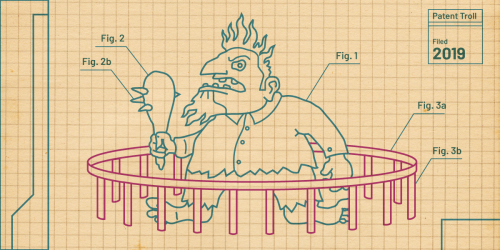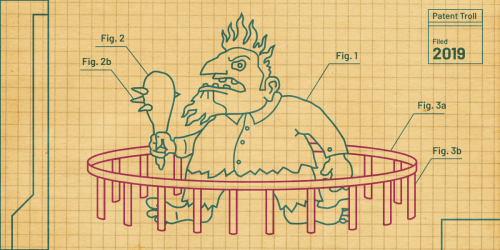The Patent Office grants thousands of patents a year, including many that would be invalidated if a court considered them. These junk patents should never be issued in the first place, but fortunately there is a way to challenge them at the Patent Office rather than wasting the courts’ time and going through expensive litigation.
Unsurprisingly, patent owners keep trying to convince the Supreme Court those post-grant challenges are unconstitutional. This week, they failed again. In United States v. Arthrex, the Supreme Court held that the administrative patent judges who preside over post-grant reviews were constitutionally appointed. That’s a relief: as we and Engine Advocacy explained in our amicus brief, the post-grant review system created has helped drive down the cost and number of patent infringement lawsuits clogging federal courts, raising consumer prices, and smothering innovation.
But the way the Supreme Court reached that outcome is a surprise: by holding the Director of the Patent Office formally accountable for each and every post-grant review decision. That may not make much of a practical difference, but symbolically, it is a crushing blow to the myth of the Patent Office as a place where technical expertise rather than political power rules. The Supreme Court’s willingness to say so could be empowering as long as we are willing to use political processes to hold the Patent Office accountable for the hugely consequential decisions it makes.
In Arthrex, the future of the post-grant review system was at stake. As we’ve written many times, this system allows granted patents to be challenged for claiming things that were known or obvious, and therefore cannot qualify as patentable inventions. We need this system because members of the public get no chance to challenge the original decision to grant a patent. That decision is made by a patent examiner. When an examiner rejects a patent, the applicant gets to request further examination and to appeal (either at the Patent Office or in federal district court). But when an examiner grants a patent, there’s no chance for the rest of us to request further examination or appeal before the patent goes into effect.
We welcome the emphasis the Supreme Court put, repeatedly, on the need for accountability at the Patent Office.
Because the Patent Office gets far more patent applications than it can carefully examine, a huge number of granted patents are found invalid when they do go to court. Because litigating invalid patents is a huge waste of time, money, and resources for companies, courts, and consumers alike, Congress created the post-grant review system as part of the America Invents Act of 2011. The system lets any member of the public petition for review, and the Patent Office is supposed to grant review as long as the petition shows the patent is likely invalid.
The America Invents Act gave the Director of the Patent Office a huge amount of power over the post-grant review process. And the Director appointed by former President Trump, Andrei Iancu, misused that power to make the process less effective, accessible, and fair. Patent owners still weren’t satisfied and challenged the whole process as unconstitutional. The Constitution includes limits and requirements for how the President may delegate authority to agencies and officers in the executive branch. Patent owners argued that the administrative patent judges who preside over post-grant reviews had so much power—specifically, the power to hold a granted patent invalid—that they could only be appointed by the President with the Senate’s consent. The Federal Circuit agreed, but opted not to nullify the post-grant review system. Instead, it eliminated the civil service protections of administrative patent judges so that the Director of the Patent Office could fire them without cause, and thus, effectively supervise their decisions. Since the Director is appointed by the President with the Senate’s consent, the Federal Circuit held that this would cure the constitutional defect.
The Supreme Court agreed that administrative patent judges needed more supervision, but instead of taking away their civil service protections, gave the Director of the Patent Office the formal power to review their post-grant review decisions, and sent the post-grant review decision in Arthrex back to the Acting Director to decide whether to exercise that power or not. It is hard to see any reason why the Acting Director would bother to review, let alone, revise the decision to invalidate the patent in Arthrex. Nevertheless, he now has the power to do so as well as the discretion to decide whether to invoke it.
The Supreme Court’s reasoning and remedy were far from unanimous. Justice Gorsuch concurred with much of the reasoning, but dissented from the result: he would have found administrative patent judges unconstitutionally appointed, nullified their appointments, and put an end to post-grant review once and for all. Justice Thomas, joined by the three liberal justices, would simply have upheld the appointment of administrative patent judges, and with it, the post-grant review system, no judicial intervention required. That reasoning—and lack of remedy—echoes the arguments EFF and Engine made in the amicus brief we submitted with the help of students and faculty at USC’s IP clinic.
Even though the majority took an entirely different approach, we welcome the emphasis they put, repeatedly, on the need for accountability at the Patent Office. The government had argued that administrative patent judges were constitutionally appointed because the Director effectively, if informally, supervised their decisions thanks to the bundle of powers he possessed—including the power to assign individual judges (including himself) to particular reviews, set the rules for their conduct, and fire them for cause. But the majority held that the Director’s enormous informal power was the problem, and that the solution was to formalize it, not nullify or diminish the position of administrative patent judges even further.
We don’t agree with the legal reasoning, but we wholeheartedly agree with the practical analysis: the Director of the Patent Office needs to be accountable through the political process for the enormous power that comes with the position. As we wait for the administration to appoint the next Director, the decision is an important and timely reminder of how much that decision matters. We must use the political process to make sure the next Director wields the power that comes with the position to improve the Patent Office’s ability to do its job: promoting the creation and dissemination of new technologies in ways that benefit the public as a whole—including our economy, health, and ability to communicate with each other.










